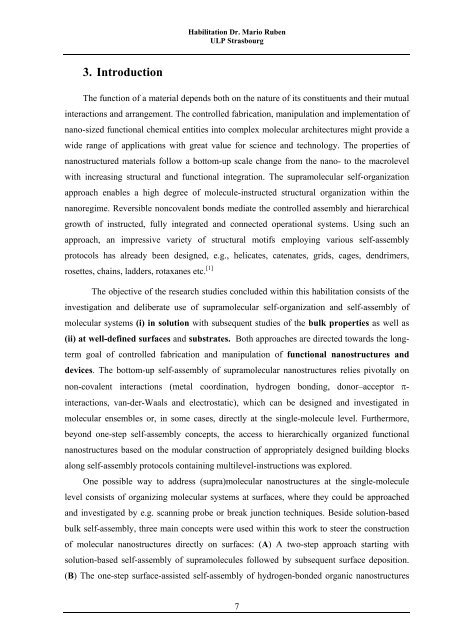Functional (Supra)Molecular Nanostructures - ruben-group
Functional (Supra)Molecular Nanostructures - ruben-group
Functional (Supra)Molecular Nanostructures - ruben-group
You also want an ePaper? Increase the reach of your titles
YUMPU automatically turns print PDFs into web optimized ePapers that Google loves.
3. Introduction<br />
Habilitation Dr. Mario Ruben<br />
ULP Strasbourg<br />
The function of a material depends both on the nature of its constituents and their mutual<br />
interactions and arrangement. The controlled fabrication, manipulation and implementation of<br />
nano-sized functional chemical entities into complex molecular architectures might provide a<br />
wide range of applications with great value for science and technology. The properties of<br />
nanostructured materials follow a bottom-up scale change from the nano- to the macrolevel<br />
with increasing structural and functional integration. The supramolecular self-organization<br />
approach enables a high degree of molecule-instructed structural organization within the<br />
nanoregime. Reversible noncovalent bonds mediate the controlled assembly and hierarchical<br />
growth of instructed, fully integrated and connected operational systems. Using such an<br />
approach, an impressive variety of structural motifs employing various self-assembly<br />
protocols has already been designed, e.g., helicates, catenates, grids, cages, dendrimers,<br />
rosettes, chains, ladders, rotaxanes etc. [1]<br />
The objective of the research studies concluded within this habilitation consists of the<br />
investigation and deliberate use of supramolecular self-organization and self-assembly of<br />
molecular systems (i) in solution with subsequent studies of the bulk properties as well as<br />
(ii) at well-defined surfaces and substrates. Both approaches are directed towards the long-<br />
term goal of controlled fabrication and manipulation of functional nanostructures and<br />
devices. The bottom-up self-assembly of supramolecular nanostructures relies pivotally on<br />
non-covalent interactions (metal coordination, hydrogen bonding, donor–acceptor π-<br />
interactions, van-der-Waals and electrostatic), which can be designed and investigated in<br />
molecular ensembles or, in some cases, directly at the single-molecule level. Furthermore,<br />
beyond one-step self-assembly concepts, the access to hierarchically organized functional<br />
nanostructures based on the modular construction of appropriately designed building blocks<br />
along self-assembly protocols containing multilevel-instructions was explored.<br />
One possible way to address (supra)molecular nanostructures at the single-molecule<br />
level consists of organizing molecular systems at surfaces, where they could be approached<br />
and investigated by e.g. scanning probe or break junction techniques. Beside solution-based<br />
bulk self-assembly, three main concepts were used within this work to steer the construction<br />
of molecular nanostructures directly on surfaces: (A) A two-step approach starting with<br />
solution-based self-assembly of supramolecules followed by subsequent surface deposition.<br />
(B) The one-step surface-assisted self-assembly of hydrogen-bonded organic nanostructures<br />
7


